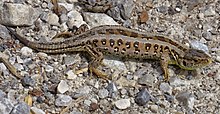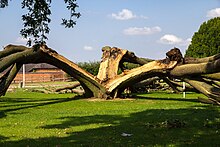Injury

Kgobalo ke go senyega ga mmele mo dithishung tse di tshelang tsa setshedi sengwe le sengwe, e ka tswa e le mo bathong, mo diphologolong tse dingwe kgotsa mo dimeleng.
Dikgobalo di ka bakwa ka ditsela di le dintsi, tse di jaaka ka metšhine ka go tsenwa ke dilo tse di bogale tse di jaaka meno kgotsa ka dilo tse di thubang, ka mogote kgotsa serame, kgotsa ka botlhole le botlhole jwa ditshedi. Go gobala go dira gore go nne le go ruruga mo diphologolong tse dintsi; seno se dira gore ntho e fole. Mo dimeleng le mo diphologolong, gantsi go ntshiwa dilo tse di thusang go tswala ntho, go fokotsa go latlhegelwa ke diedi le go tsena ga megare e e bakang malwetse e e jaaka dibaketeria. Ditshedi di le dintsi di ntsha dikhemikale tse di lwantshang megare tse di fokotsang tshwaetso ya ntho; mo godimo ga moo, diphologolo di na le ditsela tse di farologaneng tsa go lwantsha malwetse tse di dirisiwang ka boikaelelo jo bo tshwanang. Dimela le diphologolo di na le mekgwa ya go gola sesha e e ka dirang gore ntho e e gobetseng e fole gotlhelele kgotsa go se kae fela. Disele le tsone di ka kgona go baakanya tshenyo e e bakilweng ke tsone go ya bokgakaleng jo bo rileng.
Dipharologantsho
[fetola | Fetola Motswedi]Diphologolo

Kgobalo mo diphologolong ka dinako tse dingwe e tlhalosiwa jaaka tshenyo ya semotšhine mo popegong ya mmele.[1]mme e na le bokao jo bo atolositsweng jwa tshenyo ya mmele ka lebaka lefe kana lefe, go akaretsa go kgangwa ke metsi, go fisiwa le go tsenwa ke botlhole. [2]Tshenyo e e jalo e ka nna ka ntlha ya go leka go tlhasela, dintwa tsa kgaolo, go wa, le mabaka a a sa tsheleng.[3]
Kgobalo e baka karabelo ya go ruruga mo diphologolong tsa mefuta e e farologaneng;[4]seno se baka go koala ga madi kgotsa seedi sa mmele,[5] mme morago ga moo go fola ga ntho, go ka nna bonako, jaaka mo cnidaria.[6]Arthropods di kgona go baakanya dikgobalo tsa cuticle tse di bopang exoskeleton ya tsone go ya bokgakaleng jo bo rileng.[7]Diphologolo tse di farologaneng, go akaretsa di-annelids, di-arthropods, di-cnidaria, di-molluscs, di-nematode, le di-vertebrate di kgona go ntsha di-peptide tsa di-antimicrobial go lwantsha tshwaetso morago ga kgobalo.[8]
Batho

Go gobala ga batho go ile ga ithutiwa thata ka ntlha ya botlhokwa jwa gone mo go tsa kalafi. Bontsi jwa kalafi, go akaretsa kalafi ya tshoganyetso le taolo ya ditlhabi, e neetswe go alafa dikgobalo.[9] [10]Mokgatlho wa Lefatshe wa Boitekanelo o dirile thulaganyo ya go kgaoganya dikgobalo mo bathong ka ditlhopha tse di akaretsang mokgwa, dilo/dilo tse di bakang kgobalo, lefelo la go diragala ga tsone, tiro fa motho a gobetse le seabe sa maikaelelo a motho.[11] Dikgobalo di ka baka tshenyo ya tlhaloganyo go akarediwa le post-traumatic stress disorder go tlaleletsa mo tshenyong ya mmele. [12]
Dijwalo

Mo dimeleng, dikgobalo di tlholwa ke go jewa ga dikarolo tsa dimela ke diphologolo tse di jang dimela go akaretsa ditshenekegi le diamusi,[13] go tswa mo tshenyong ya dithishu ke megare ya dimela jaaka dibaketeria le di-fungus, tse di ka tsenang morago ga tshenyo ya dimela kgotsa ka ditsela tse dingwe,[14] le go tswa mo dilong tse di sa tsheleng tse di jaaka mogote,[15] go tsidifala [16]merwalela,[17] legadima,[18]le kgotlelo[19] jaaka ozone.[20] Dimela di tsibogela kgobalo ka go supa gore tshenyo e diragetse,[21] ka go ntsha dikhemikale go tswalela lefelo le le senyegileng,[22]ka go ntsha dikhemikale tse di lwantshang megare,[23][24] le mo dimeleng tsa logong ka go gola gape mo dintlheng.[25][26][27]
Tshenyo ya disele
[fetola | Fetola Motswedi]Tshenyo ya disele ke diphetogo tse di farologaneng tsa kgatelelo tse disele di di itemogelang ka ntlha ya diphetogo tsa tikologo tsa kwa ntle le tsa kwa teng. Gareng ga dilo tse dingwe, seno se ka bakwa ke dilo tsa mmele, dikhemikale, malwetse a a tshelanwang, dilo tse di amanang le mmele, dikotla kgotsa dilo tse di amanang le thulaganyo ya mmele ya go lwantsha malwetse. Go senyega ga disele go ka fetoga kgotsa ga se ka ga fetoga. Go ikaegile ka bogolo jwa kgobalo, karabo ya disele e ka nna ya fetoga mme fa go kgonegang, homeostasis e busediwa.[28] Loso lwa disele lo diragala fa bokete jwa kgobalo bo feta bokgoni jwa disele go itsosolosa. [29]Loso lwa disele le amana le boleele jwa nako ya go nna mo thothobolong e e kotsi le bokete jwa tshenyo e e bakilweng. [30]
Metswedi
[fetola | Fetola Motswedi]- ↑ Rennolds, Corey W.; Bely, Alexandra E. (29 September 2022). "Integrative biology of injury in animals". Biological Reviews. 98 (1): 34–62. doi:10.1111/brv.12894. ISSN 1464-7931. PMC 10087827. PMID 36176189.[1]
- ↑ de Ramirez, Sarah Stewart; Hyder, Adnan A.; Herbert, Hadley K.; Stevens, Kent (2012). "Unintentional injuries: magnitude, prevention, and control". Annual Review of Public Health. 33: 175–191. doi:10.1146/annurev-publhealth-031811-124558. ISSN 1545-2093. PMID 22224893.[2]
- ↑ de Ramirez, Sarah Stewart; Hyder, Adnan A.; Herbert, Hadley K.; Stevens, Kent (2012). "Unintentional injuries: magnitude, prevention, and control". Annual Review of Public Health. 33: 175–191. doi:10.1146/annurev-publhealth-031811-124558. ISSN 1545-2093. PMID 22224893.[3]
- ↑ Sparks, Albert (1972). Invertebrate Pathology Noncommunicable Diseases. Academic Press. pp. 20, 133. ISBN 9780323151962.[4]
- ↑ Cerenius, Lage; Söderhäll, Kenneth (6 November 2010). "Coagulation in Invertebrates". Journal of Innate Immunity. 3 (1): 3–8. doi:10.1159/000322066. ISSN 1662-811X. PMID 21051883. S2CID 20798250.[5]
- ↑ Sparks, Albert (1972). Invertebrate Pathology Noncommunicable Diseases. Academic Press. pp. 20, 133. ISBN 9780323151962[6]
- ↑ Parle, Eoin; Dirks, Jan-Henning; Taylor, David (2016). "Bridging the gap: wound healing in insects restores mechanical strength by targeted cuticle deposition". Journal of the Royal Society Interface. 13 (117): 20150984. doi:10.1098/rsif.2015.0984. ISSN 1742-5689. PMC 4874426. PMID 27053653.[7]
- ↑ Rennolds, Corey W.; Bely, Alexandra E. (29 September 2022). "Integrative biology of injury in animals". Biological Reviews. 98 (1): 34–62. doi:10.1111/brv.12894. ISSN 1464-7931. PMC 10087827. PMID 36176189
- ↑ Ahmadi, Alireza; Bazargan-Hejazi, Shahrzad; Heidari Zadie, Zahra; et al. (2016). "Pain management in trauma: A review study". Journal of Injury and Violence Research. 8 (2): 89–98. doi:10.5249/jivr.v8i2.707. ISSN 2008-4072. PMC 4967367. PMID 27414816.[8]
- ↑ Maerz, Linda L.; Davis, Kimberly A.; Rosenbaum, Stanley H. (2009). "Trauma". International Anesthesiology Clinics. 47 (1): 25–36. doi:10.1097/AIA.0b013e3181950030. ISSN 1537-1913. PMID 19131750. S2CID 220567282
- ↑ "International Classification of External Causes of Injury (ICECI)". World Health Organization. Archived from the original on 17 October 2004. Retrieved 22 September 2023.[9]
- ↑ Agarwal, Tulika Mehta; Muneer, Mohammed; Asim, Mohammad; et al. (2020). "Psychological trauma in different mechanisms of traumatic injury: A hospital-based cross-sectional study". PLOS ONE. 15 (11): e0242849. Bibcode:2020PLoSO..1542849A. doi:10.1371/journal.pone.0242849. ISSN 1932-6203. PMC 7703890. PMID 33253298.[10]
- ↑ Tarr, S. A. J. (1972). "Plant injury due to insects, mites, nematodes and other pests". Principles of Plant Pathology. London: Macmillan. pp. 126–137. doi:10.1007/978-1-349-00355-6_9. ISBN 978-1-349-00357-0.[11]
- ↑ Cappelli, Seraina Lisa; Koricheva, Julia (2 July 2021). "Interactions between mammalian grazers and plant pathogens: an elephant in the room?". New Phytologist. 232 (1). Wiley: 8–10. doi:10.1111/nph.17533. ISSN 0028-646X. PMID 34213785. S2CID 235708670.[12]
- ↑ Smillie, R.M.; Nott, R. (1979). "Heat Injury in Leaves of Alpine, Temperate and Tropical Plants". Functional Plant Biology. 6 (1). CSIRO Publishing: 135. doi:10.1071/pp9790135. ISSN 1445-4408.[13]
- ↑ Burke, M. J.; Gusta, L. V.; Quamme, H. A.; Weiser, C. J.; Li, P. H. (1976). "Freezing and Injury in Plants". Annual Review of Plant Physiology. 27 (1). Annual Reviews: 507–528. doi:10.1146/annurev.pp.27.060176.002451. ISSN 0066-4294.[14]
- ↑ Kramer, Paul J. (1 October 1951). "Causes of Injury to Plants Resulting from Flooding of the Soil". Plant Physiology. 26 (4). Oxford University Press: 722–736. doi:10.1104/pp.26.4.722. ISSN 0032-0889. PMC 437542. PMID 16654407.[15]
- ↑ Nelson, Scot C. (July 2008). "Lightning Injury to Plants" (PDF). Plant Disease (PD-40).[16]
- ↑ Heath, R. L. (1980). "Initial Events in Injury to Plants by Air Pollutants". Annual Review of Plant Physiology. 31 (1). Annual Reviews: 395–431. doi:10.1146/annurev.pp.31.060180.002143. ISSN 0066-4294.[17]
- ↑ Hill, A. C.; Pack, M. R.; Treshow, M. (1961). "Plant injury induced by ozone". Phytopathology. 51. OSTI 5518148.[18]
- ↑ Turlings, Ted C.; Tumlinson, James H. (1992). "Systemic release of chemical signals by herbivore-injured corn". Proceedings of the National Academy of Sciences. 89 (17): 8399–8402. Bibcode:1992PNAS...89.8399T. doi:10.1073/pnas.89.17.8399. PMC 49926. PMID 11607325.[19]
- ↑ Sun, Qiang; Rost, Thomas L.; Matthews, Mark A. (2008). "Wound-induced vascular occlusions in Vitis vinifera (Vitaceae): Tyloses in summer and gels in winter1". American Journal of Botany. 95 (12). Wiley: 1498–1505. doi:10.3732/ajb.0800061. ISSN 0002-9122. PMID 21628157.[20]
- ↑ Shigo, Alex L. (1985). "Compartmentalization of Decay in Trees". Scientific American. 252 (4): 96–103. Bibcode:1985SciAm.252d..96S. doi:10.1038/scientificamerican0485-96. hdl:2027/uva.x002416568. ISSN 0036-8733.[21]
- ↑ González-Lamothe, Rocío; Mitchell, Gabriel; Gattuso, Mariza; Diarra, Moussa; Malouin, François; Bouarab, Kamal (31 July 2009). "Plant Antimicrobial Agents and Their Effects on Plant and Human Pathogens". International Journal of Molecular Sciences. 10 (8). MDPI AG: 3400–3419. doi:10.3390/ijms10083400. ISSN 1422-0067. PMC 2812829. PMID 20111686.[22]
- ↑ Shigo, Alex L. (1985). "How tree branches are attached to trunks". Canadian Journal of Botany. 63 (8): 1391–1401. doi:10.1139/b85-193.[23]
- ↑ O'Hara, Kevin L. (2007). "Pruning Wounds and Occlusion: A Long-Standing Conundrum in Forestry". Journal of Forestry. 105 (3): 131–138. doi:10.1093/jof/105.3.131. S2CID 10075580.[24]
- ↑ "Tree pruning guide". US Forest Service for the US Department of Agriculture. Archived from the original on 26 April 2007.[25]
- ↑ Wolf, Ronni; et al. (2011). Emergency Dermatology. Cambridge University Press. pp. 1–10. ISBN 9780521717335.[26]
- ↑ Cobb, J. P.; et al. (1996). "Mechanisms of cell injury and death". British Journal of Anaesthesia. 77 (1): 3–10. doi:10.1093/bja/77.1.3. PMID 8703628.[27]
- ↑ Wolf, Ronni; et al. (2011). Emergency Dermatology. Cambridge University Press. pp. 1–10. ISBN 9780521717335.[28]
